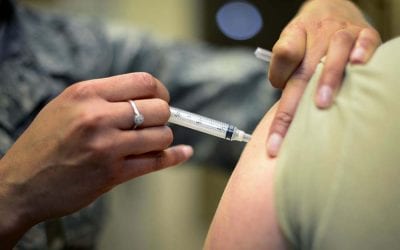You might have read about the controversial comments Rob Hummel, president of Legend3D, Inc. made in June, at the Cine Gear Expo in Los Angeles, about problems for travelers’ who bring digital cameras on their plane flights. Hummel claimed gamma ray radiation destroys digital camera sensors’ pixels while flying above 20,000 feet.
Hummel delivered his remarks during his presentation, “Primer on Film and Digital Capture.” The controversial statements, which begin about eight minutes into the presentation, have received much play on the Internet and in the press.
Travelers in many photo and travel forums have been asking if Hummel’s claims are true, ever since the presentation was posted on YouTube. They’re concerned about their vacation photos, and digital cameras being ruined while flying.
Hummel stated,
“There’s a little problem though with digital cameras, I promise you. Anybody ever take their cameras on an airplane? OK … Every time you do that you kill photosites on your camera, because of … When Canon, Nikon, Casio, Panasonic ship cameras to North America, they do it by boat. And that’s because you need about … at at altitudes of 20,000 feet and higher you need about 125 feet of concrete to shield yourself from the gamma rays at higher altitudes. They don’t hurt us, but gamma rays induce voltages in sensors that fry out pixels.”
Before Hummel completed his presentation, I became leery of his statements, and questioned the claims made in the presentation. When Hummel said, “They don’t hurt us,” referring to gamma rays, I was astonished!
All ionizing radiation causes damage at a cellular level, but because alpha and beta radiation are relatively non-penetrating, they are not nearly as hazardous as gamma radiation.
According to the Environmental Protection Agency,
“Because of the gamma ray’s penetrating power and ability to travel great distances, it is considered the primary hazard to the general population during most radiological emergencies.”
In fact, high doses of gamma radiation are extremely harmful to humans, and can cause cancer and radiation sickness. To say without qualification that gamma radiation isn’t harmful to humans, as Hummel stated, is ridiculous.
In the presentation, Hummel talks about a Canon camcorder which he claimed was damaged by gamma radiation. Popular Photography staffers, thought what he said was so dubious they went directly to Canon to see if they were familiar with the problem.
Canon’s official statement about the issue, published by Popular Photography on their PopPhoto.com website states,
“Canon disagrees with these findings based upon the lack of customer complaints, shipping methods and specific Canon technology that eliminate the issues Mr. Hummel describes.”
Hummel stated, “Film is immune from gamma rays.” French physicist Antoine Becquerel, discoverer of radioactivity along with Marie and Pierre Curie, (All three won the 1903 Nobel Prize in Physics) proved that isn’t true in 1896. Becquerel discovered he could detect gamma radiation, as its invisible radiation affected silver emulsions on photographic plates just like light rays.
In the presentation, Hummel stated that by killing sensor “transfer pixels,” gamma rays, would deaden an entire row of pixels, producing a black line on every image. If this were happening regularly to air travelers’ digital cameras, considering the number of people flying with them, there would be a ground swell of complaints. To the best of my knowledge air travelers haven’t been making such complaints.
Delving into the numbers, a 2002 study about the effect of Gamma-ray radiation on color CMOS image sensors, like those used in many DSLRs, showed 600Gy (Grays) would kill them, but a 2008 UN report about the effects of radiation on people points out that the average annual effective dose of overall radiation for airline flight crews, including gamma radiation, is only 3.0 mGy (Milligrays).
Combined, these studies would seem to clearly indicate the typical digital camera sensor is pretty safe from gamma ray damage when travelers take them on their plane flights to destinations across the globe.
Can gamma radiation kill pixels of digital cameras? Absolutely. This has been known for a long time. NASA’s been using Nikon digital cameras in space for years.
A NASA spokesperson has said, “The space environment (both inside the vehicle and on spacewalks) is tough on the electronic cameras. The radiation damages pixels on the sensor.”
That being said, there is a world of difference, in radiation exposure, at the altitudes travelers fly in commercial jets, even on long distance flights, compared to flying in the Space Shuttle, or the International Space Station.
Since I purchased my first DSLR, a Nikon D70, I’ve flown more than a hundred thousand miles as a travel photographer, and on vacation. So far, my digital cameras haven’t had any dead pixels on their sensors.
I think you can bring your digital camera on your next vacation flights, and safely expect it will arrive at your destination without gamma radiation damage.
Ned Levi is a long time professional photographer with a passion for wildlife and travel photography. You can view some of Ned’s travel and other photos at NSL Photography or get more travel photography advice at the NSL Photography Blog.
After many years working in corporate America as a chemical engineer, executive and eventually CFO of a multinational manufacturer, Ned founded a tech consulting company and later restarted NSL Photography, his photography business. Before entering the corporate world, Ned worked as a Public Health Engineer for the Philadelphia Department of Public Health. As a well known corporate, travel and wildlife photographer, Ned travels the world writing about travel and photography, as well as running photography workshops, seminars and photowalks. Visit Ned’s Photography Blog and Galleries.


